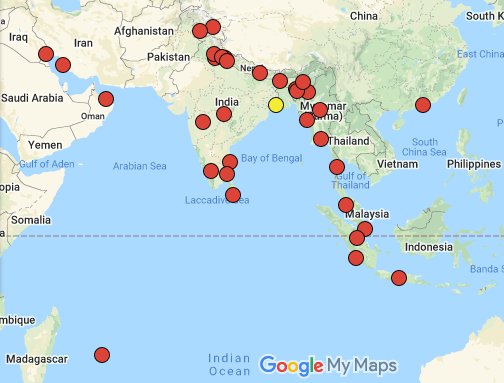By Henry Noltie & Mark Watson
Nathaniel Wallich was one of the most significant superintendents of the Calcutta Botanic Garden (now the AJC Bose Indian Botanic Garden, Howrah), a post he held formally from 1817 (acting during periods from 1815) until 1846. His indirect predecessor William Roxburgh, largely on account of the climate and insect pests, had not kept dried plant material in Calcutta (for ‘vouchers’ relying largely on paintings), but had sent numerous specimens to European correspondents and institutions, including the India Museum of the East India Company (EIC) housed in its HQ in Leadenhall Street, London.
Other similar collections had been received by the EIC following the foundation of the Museum in 1800, but with enormous energy, and using a variety of means, Wallich started to amass large amounts of dried specimens at the Garden. Their final location (whether Calcutta or Europe) was probably at this point unthought of, though some of the earliest specimens he received from Nepal were despatched to Britain. Wallich himself collected assiduously on various sick leaves and on excursions made on the Company’s behalf, which resulted in the addition of specimens from Mauritius, Nepal, the Gangetic Plains, Burma, Penang and Singapore.

by permission of the Linnean Society of London
Wallich also received specimens from Company officials based in all four of the Presidencies into which the administration of British India was organised: Bengal, Bombay, Madras and Prince of Wales Island (later Penang, which came to include Malacca and Singapore). These officials held posts in a variety of services, especially the medical and military. All of these were men and only a single woman (the wife of the Governor-General) sent him specimens from within India. As Superintendent of the Garden Wallich also persuaded the Bengal government to agree to pay for professional plant collectors who were deployed to areas known to be botanically rich, notably to Nepal, ‘Silhet’ (chiefly the Khasia Hills, between Bengal and Assam), and the Western Himalaya.
The geographical origins of the specimens were wide, from throughout the territories within the ambit of the ‘United Company of Merchants Trading to the East Indies’. The ‘East Indies’ stretched through 70 degrees of longitude and 55 of latitude, from Iraq in the west, through India and Nepal to Singapore, Sumatra and Canton in the east, and from Ladakh in the north to Mauritius in the south. The collectors and correspondents sent not only herbarium specimens, but timber samples, fruits in spirits, seeds, roots, cuttings and even potted plants for propagation and cultivation in Calcutta. Contributions for the Garden also came from abroad and specimens made from cultivated plants feature prominently in Wallich’s great Herbarium.
In 1828 he obtained a two-and-half-year leave from the Garden, while retaining his substantial superintendent’s salary. This was in part on the grounds of Wallich’s life-threatening ill-health, but in part as a scientific sabbatical as he was allowed to take the as yet unmounted herbarium, related three-dimensional specimens, and 1200 drawings by the Garden’s artists, with him. Even by this stage, though he had never visited it, England was by now seen as ‘home’ – his wife and four children had been there for almost four years, and London, with its libraries, experts and herbaria was the only place where Wallich could hope to curate the Herbarium and publish some of his extraordinary discoveries.
The collections were packed in 30 barrels weighing 20 tons and, from a rented house at 61 Frith Street, Soho, and with the help from taxonomic experts from across Europe, he curated the enormous collection, identifying specimens, giving them names (there was no time to provide these with descriptions), and sorting them into more than 60 duplicate sets (of widely varying degrees of completeness). After two extensions to Wallich’s furlough (he remained in London from July 1828 to October 1832) the names and collecting details were written up in a vast catalogue that was reproduced by the novel technology of lithography, which could be cut up to use as labels by recipients of the duplicate specimens.
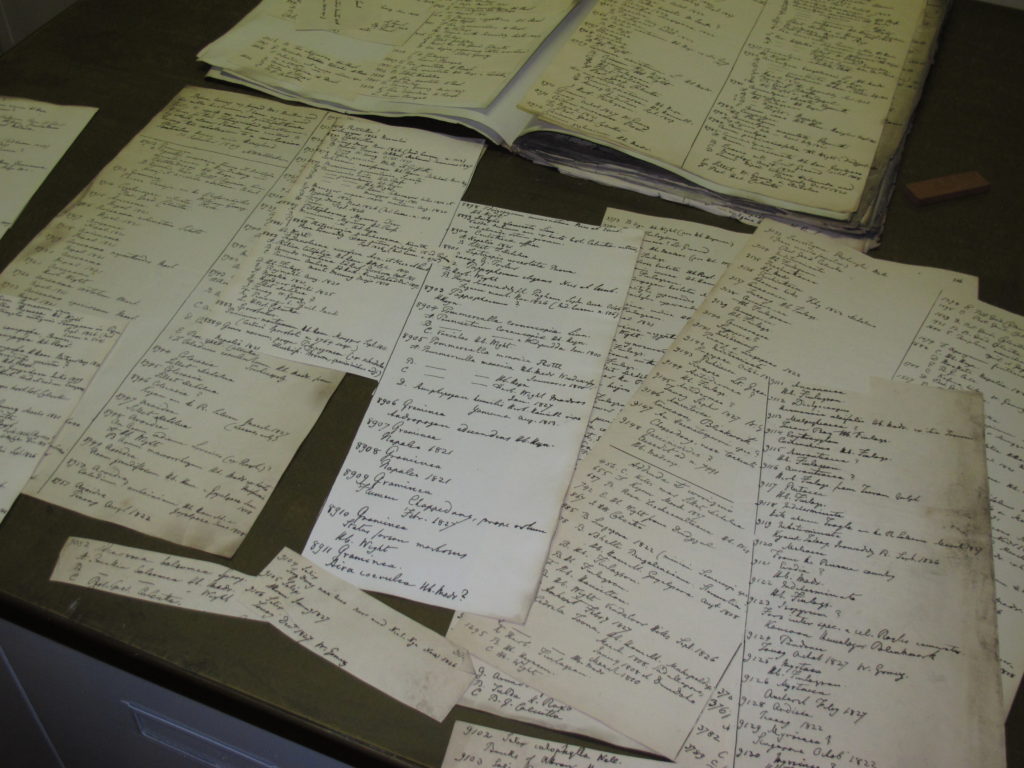
To bibliographic pedants it is known as ‘A numerical list of dried specimens of plants in the East India Company’s Museum, collected under the superintendence of Dr. Wallich of the Company’s Botanic Garden at Calcutta’; to working botanists, with a reverence for the contribution of their predecessors, it is more affectionately and appropriately known as the ‘Wallich Catalogue’. Likewise, the herbarium itself, kept at Kew since 1913, is known not by its official title of the ‘Herbarium of the Honorable East India Company’, but as the ‘Wallich Herbarium’ (‘the Herbarium’ hereafter; its acronym ‘K-W’), in memory of its creator rather than its (at times far-from-willing) patron.
In the Catalogue each species received a number, with a letter- or number-suffix denoting collections from different places and/or collectors (few are dated). Eventually it proved to contain more than 9,000 species and ‘the great Indian herbarium’ was described by Joseph Hooker, not known for his generosity with praise, as ‘the most valuable contribution of the kind ever made to science’. Wallich himself was rightly proud of it and, while denoting himself a molehill, a mouse or a nightshade, as compared with the lion, Atlas or oak of the great Alexander von Humboldt, could not help but point out to William Hooker that his Herbarium was much larger than that brought back from the Americas by the great Prussian savant.
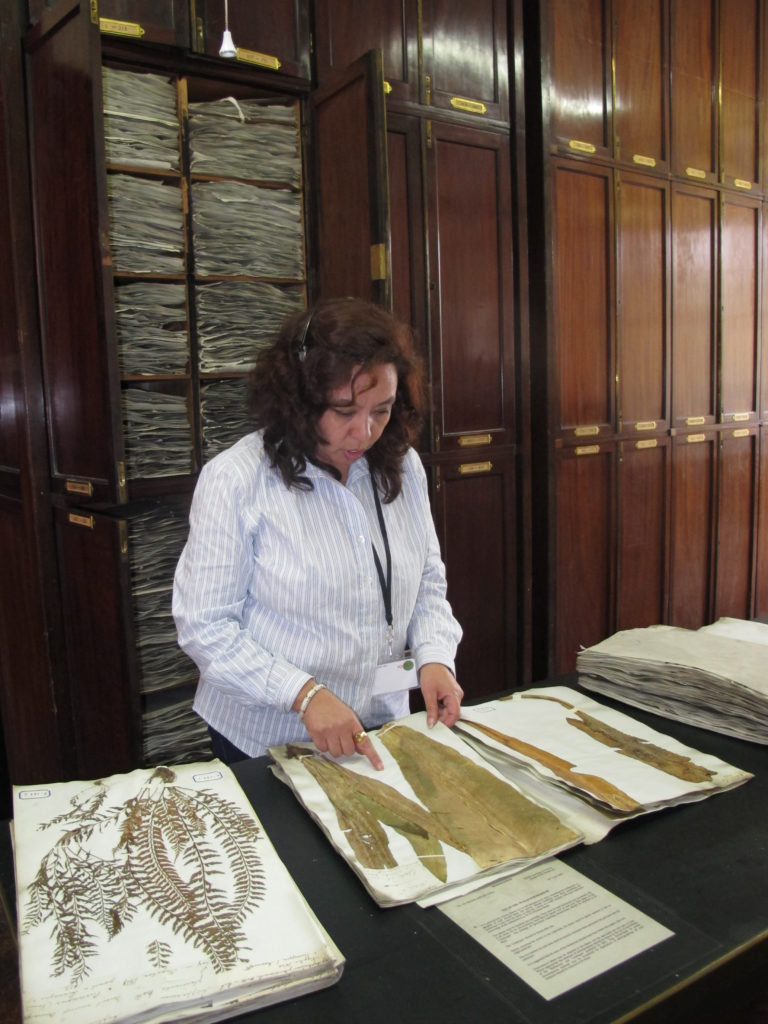
At RBGE, led by MW, and in collaboration with colleagues at Kew, a project was undertaken between 2008 and 2015 to unravel the considerable complexities of the Wallich Catalogue and Herbarium, and to make them available online and interactively. This, in a way, was an updating of an earlier project, as in 1970 the herbarium sheets had been photographed by the Inter Documentation Company (IDC) and published as 320 microfiche images, supplemented the following year by a microfiched version of the Catalogue. With these was published a booklet by Alan Radcliffe Smith and T.J. Parsons with introductory notes on the Herbarium including geographical information and biographical details of the collectors. The ‘Wallich Catalogue Online’, on the RBGE website, is up and running and has been used by taxonomists all over the world, as the specimens in the Herbarium are foundational to the classification and naming of S and SE Asia plants.
The Wallich Catalogue website continues to be added to and developed and, as a lockdown project, MW asked HN to compile information on the collectors represented. This expands the work of Smith and Parsons as in recent years much additional information has become available, not least from web sources. This discussion is restricted to those who contributed to the Herbarium itself (including those who sent material cultivated in the Garden from which specimens were made), but excluded Wallich’s own contribution and those of the makers of earlier collections that the EIC asked Wallich to take, curate and distribute as part of his labours (those of Francis Buchanan-Hamilton, George Finlayson, Benjamin Heyne, William Roxburgh, Patrick Russell, Robert Wight, and the Tranquebar Missionaries).
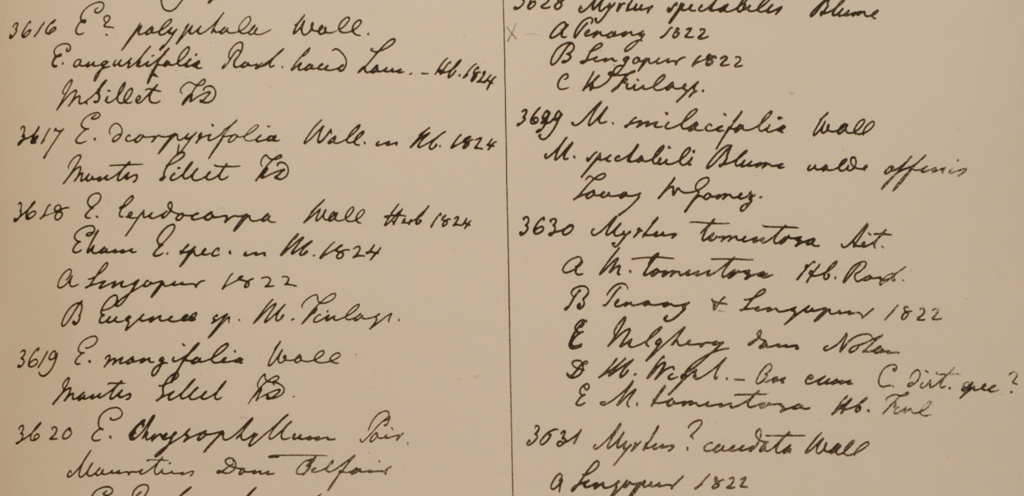
The purpose here is not a comprehensive discussion of the collectors and their biographical details but an anecdotal overview – providing background context as to how and why the collections came from the places they did, and why the collectors were there when they were. While herbaria can be seen as stacks of paper, data, and dead, brownish plant material primarily of ‘scientific’ interest, especially ones with complex origins such as Wallich’s, are far more than that. The Herbarium is a rich and complex artefact that cannot help but be a product of its time and therefore incorporate at least traces of wider historical and cultural events. Many new and interesting stories and biographical details have emerged, often relating to individuals who contributed very small numbers of specimens. Of the more than 11,500 specimens documented in the RBGE project as being assembled by Wallich in Calcutta the largest contribution, no fewer than 7,700 specimens, was that made by the man himself (strictly speaking these are ones that are not attributed to others).
In order to present these people and their stories in digestible servings, they are presented in four parts, the first of which is given here, the rest to follow in three linked articles:
I) Calcutta Botanic Garden Plant Collectors
III) Horticulturists and Civil Servants
IV) Military Men, Society Ladies and the French

Part I. Calcutta Botanic Garden Plant Collectors
After Wallich’s own, by far the largest number of specimens in the Herbarium (almost 3,000) are from the seven Plant Collectors employed by the Garden between 1817 and 1828. While their boss was scrupulous in ensuring adequate pay for these men, and often recorded their names in the Catalogue, these individuals are the least known of all the contributors. As low-status ‘subalterns’ they have left little trace in the paper record on which historical research is largely based.
By far the largest of these contributions is that of Francis De Silva, who was described by Buchanan-Hamilton as ‘Portuguese’, and as the son of one of ‘Roxburgh’s old servants’. As a boy he started as an assistant to a Chinese gardener in the Calcutta Garden, but in 1817 was sent by Wallich as a plant collector to Nepal with Bharat Singh, where De Silva remained until January 1820 when he was replaced by Robert Blinkworth (discussed below). De Silva was the scribe of the team, documenting the collections and preparing the material for the almost daily dispatches to Calcutta. Singh had previously been employed as a collector on the Bengal Survey by Buchanan-Hamilton, who described him as a ‘Rajput’, suggesting that he was of Kshatriya as opposed to Brahmin caste.
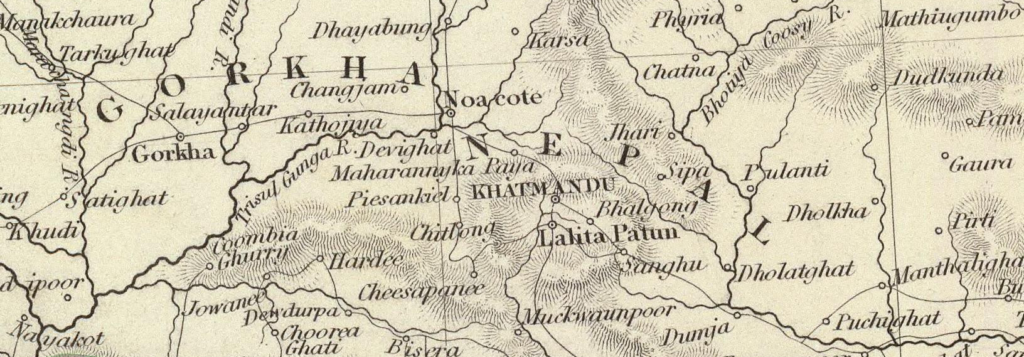
From a base at the British Residency near Kathmandu De Silva and Singh worked under the eye of Wallich’s correspondent Edward Gardner, Resident to the Court of Nepal, and his deputy Robert Stuart. Political relations were ticklish as the Resident had been imposed on an unwilling Court as a result of the Treaty of Sugauli following the Gorkha War. De Silva’s pale complexion initially raised suspicions that he wasn’t Indian, but the difficulties were overcome and the pair, with Gardner’s own collectors and gardeners, collected extensively in and around the Kathmandu Valley. However, with the exception of a few specimens, these early Nepalese collections do not form part of the Herbarium. The 12 specimens attributed to Singh were collected in 1821, from the Gossain Than in the mountains to the north, whilst Wallich himself, restricted in his movements by the Nepalese authorities, was conducting operations in and around Kathmandu.
The c 1,200 De Silva specimens all come from his next phase of activity as a Plant Collector, which began probably in 1820, the year following the death of Matthew Smith, in the area denoted by Wallich as ‘Silhet’. Sylhet is now in Bangladesh, a large city in its northern plains that in De Silva’s day were largely impenetrable swamps, and most of the collections come from the Khasia and Jaintia Hills that rise to the north, and are now in the Indian State of Meghalaya. The hills were explored from the village known as Pundua at the foot of the hills, on the route up to Cherrapunji, close to what is marked on modern maps as ‘Companiganj’ and De Silva is said to have operated from a boat previously owned by Smith.
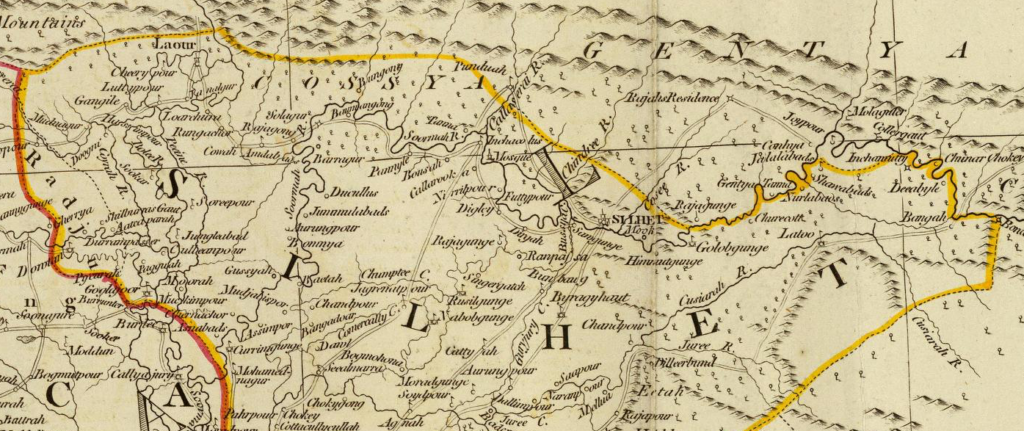
Two other Garden Collectors were active in the Sylhet region in the 1820s, William Gomez and Henry Bruce, both of whom were recruited as boys by Wallich in 1819 from the Free School in Calcutta, and trained at the Garden under George Porter. Nothing is known of the boys’ backgrounds, but they are likely to have been either orphans or Anglo-Indian, the two groups for which the school largely catered. Bruce collected some 215 specimens, all in the Sylhet region, but while many of Gomez’s c 770 collections are also from there, more are from Burma, where he accompanied Wallich in 1826/7.
Wallich’s visit to Burma came hard on the heels of the Treaty of Yandobo that followed the bloody and expensive First Anglo-Burmese War of 1824–6. The Burmese states of Arakan in the north (now the infamous Rakhine State) and Tenasserim in the south were ceded to the EIC, as were Burmese claims to Assam. One of the great interests of these territories was their rich teak forests (which had been Burmese royal property), and one of Wallich’s aims was to survey these though he also visited Ava, which remained Burmese. He took his two artists with him, the senior artist Gorachand (who died in Burma), and Vishnupersaud. A second plant collector called Akkul Mahmud, who appears to have specialised in grasses, accompanied the party to Burma, who contributed 18 specimens to the Herbarium (including a few from Chittagong).
In the early 1820s the riches of the Western Himalaya were becoming known as a result of exploration from the Saharunpur Garden under George Govan, and by botanically-minded army officers engaged in the Gorkha War. Wallich also sent plant collectors there – to Kumaon and Garhwal (the eastern western divisions of the present-day State of Uttarakhand) and Sirmur (the southernmost part of Himachal Pradesh, immediately to the north of Saharunpur). The most prolific of these was Richard Walter Blinkworth (b 1800) (c 670 specimens), with a smaller number from a collector called Kamrup (73).

Blinkworth, who was born in Calcutta of a possibly Anglo-Indian father and perhaps, as un-named, an Indian mother, is first recorded as collecting with Bharat Singh in Nepal, replacing De Silva in January 1820. By 1824 he had moved to Almorah (Kumaon) where, in 1825, he fathered his first son with an unmarried Indian woman, and later regularised his family by marrying the twelve-year old (sic) Arabella, daughter of Thomas Penn, deceased riding master of the 3rd Bengal Native Cavalry. Blinkworth was employed as a plant collector by Calcutta until 1839 when he was transferred to the Saharunpur Garden. Thereafter he ran the Kumaon and Garhwal tea plantations from Almorah where, with Chinese labour, the first crop was produced in 1842. He ran the tea plantations for three or four years before being pensioned off.
Of Kamrup little is known other than that in David Don’s Prodromus Florae Nepalensis (1825) it is recorded that he was a Brahmin. Kamrup collected around Srinagar – not the better known one in Kashmir, but the main town of the Garhwal hills. Once the capital of the Gahwal Kingdom, but taken over by the Gorkhas in 1806, it was then in British territory and is now in the Indian State of Uttarakhand. His name should not be confused with the Kamrup district of Assam.

